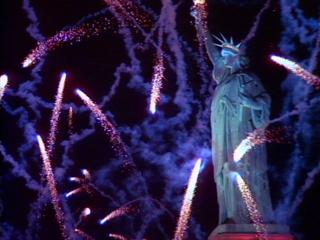The Statue of Liberty
 This 302-foot tall copper statue, formally called "Liberty
Enlightening the World," stands on Liberty Island in the Upper Bay of New
York Harbor. The statue, which represents a woman raising her torch to proclaim
liberty, was a gift from the people of France to the people of the United States,
in honor of the U.S. centennial in 1876.
This 302-foot tall copper statue, formally called "Liberty
Enlightening the World," stands on Liberty Island in the Upper Bay of New
York Harbor. The statue, which represents a woman raising her torch to proclaim
liberty, was a gift from the people of France to the people of the United States,
in honor of the U.S. centennial in 1876.
French historian Edouard de Laboulaye first proposed the gift, and the French people raised money so that, in 1875, sculptor Frederic-Auguste Bartholdi's team could began work on the colossal statue. The statue is constructed of hand-hammered copper sheets assembled over a framework of steel supports, designed by Eugene Emmanuel Viollet-le-Duc and Alexandre-Gustave Eiffel.
The completed statue, weighing nearly 225 tons, was disassembled and shipped to New York for reassembly on a pedestal designed by American architect Richard Morris Hunt. The Emma Lazarus sonnet, "The New Colossus," with its famous line "give me your tired, your poor, your huddled masses..." is inscribed in the pedestal. The Statue of Liberty was dedicated by President Cleveland on October 28, 1886.
 The Statue of Liberty was originally called "Liberty
Enlightening the World". The statue is situated on the Statue of Liberty Island,
formerly known as "Bedloe's Island", which is located in New York harbour. In
1924, the statue, the island and the nearby island (Ellis Island) were declared
as being a national monument.
The Statue of Liberty was originally called "Liberty
Enlightening the World". The statue is situated on the Statue of Liberty Island,
formerly known as "Bedloe's Island", which is located in New York harbour. In
1924, the statue, the island and the nearby island (Ellis Island) were declared
as being a national monument.
From 1983 through 1986, a massive rehabilitation project replaced the iron armature, which had rusted, with one of stainless steel and replaced the statue's leaky glass-and-metal torch with one of gilded copper.
One of the largest statues in the world. The Statue of Liberty rises 93.5 m from the bottom of the pedestal to the tip of the torch. The figure alone is 46.4 m high, the right arm is 12.8 m long; the hand is 5.03 m long, and the head, which is reachable by staircase or emergency elevator, measures 8.5m from neck to diadem and 3.05 m from ear to ear. The statue weighs 254 metric tons.
Originally conceived as a gesture of international friendship, the statue has become a global symbol of freedom, marking the arrival of millions of immigrants to the United States.
Some Quick Facts About the Statue of Liberty

- In 1884, the statue was given to the people of the United States by the people of France.
- The statue was given by France to the United States to commemorate the centennial of US independence.
- The Statue of Liberty was designed by French sculptor Frederic-Auguste Bartholdi
- The pedestal was designed by the American architect Richard Morris Hunt.
- The statue was dedicated by President Grover Cleveland on October 28, 1886.
- The total cost of the Statue was $800,000.
- The figure was formed of copper sheets riveted to an iron framework as part of a support system, by the French civil engineer Alexandre Gustave Eiffel.
- The original name of the Statue of Liberty Island was Bedloe's Island.
The Symbolism of the Statue
The statue shows liberty as a proud woman draped in the graceful folds of a loose robe. In her uplifted right hand, she holds a glowing torch. She wears a crown with seven spikes that stand for the light of liberty shining on the seven seas and seven continents. With her left arm, she cradles a tablet bearing the date of the American Declaration of Independence (July 4, 1776). A chain that represents tyranny lies broken at her feet.For immigrants entering the United States, the statue was a strong, welcoming figure holding out the promise of freedom and opportunity.